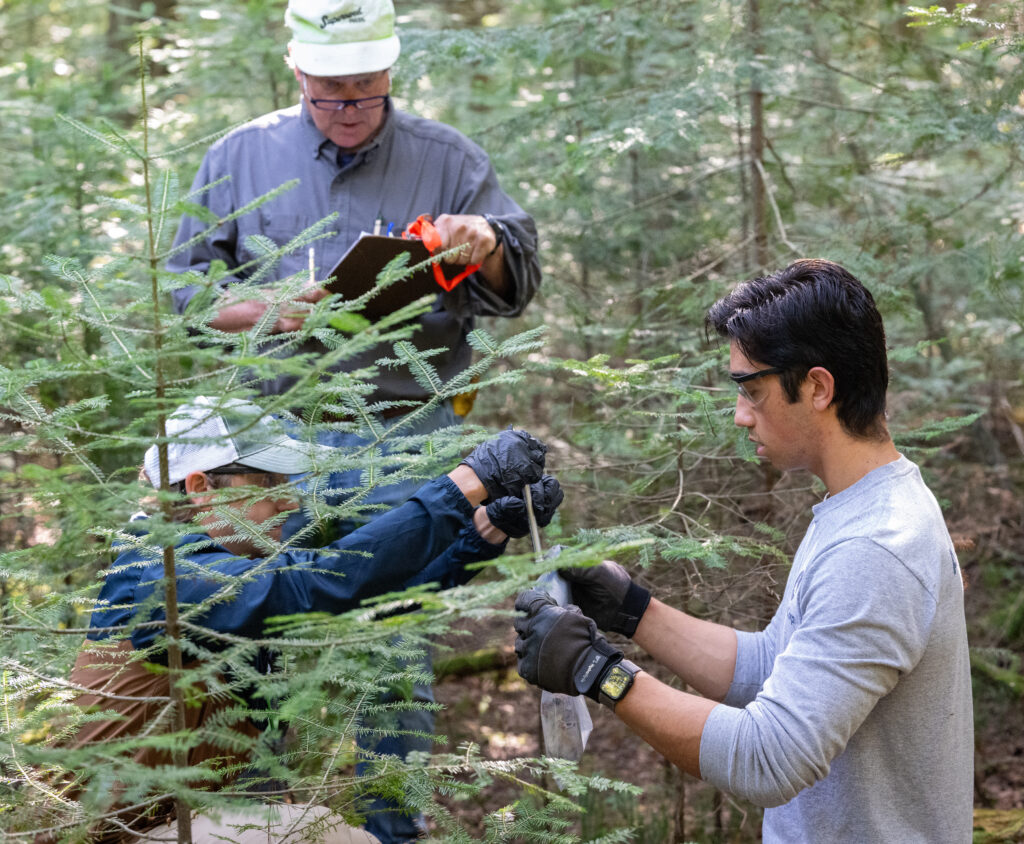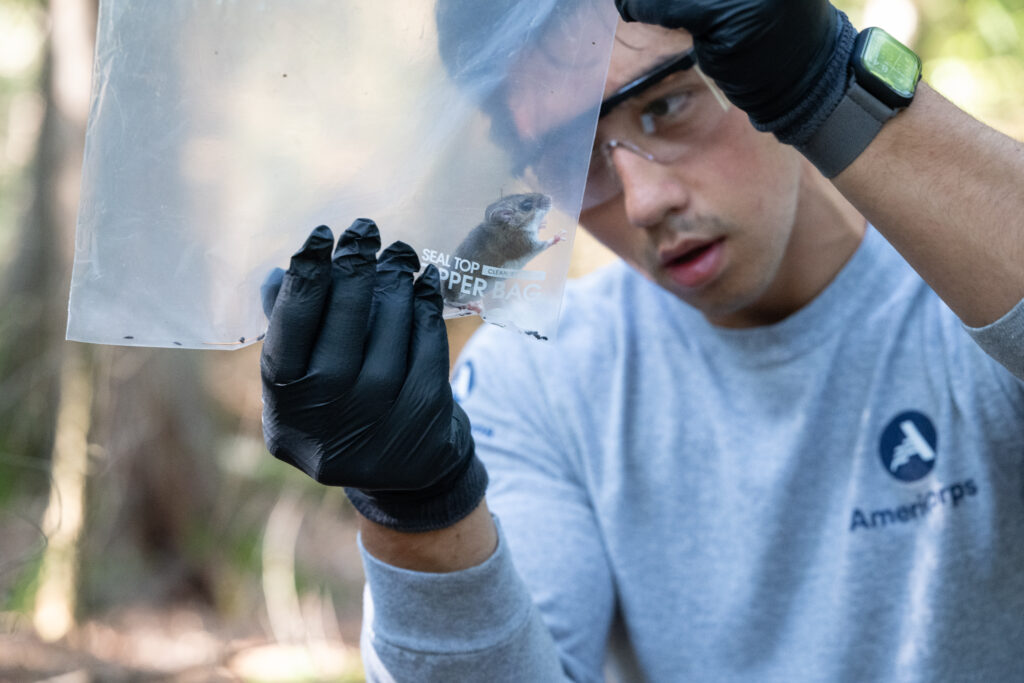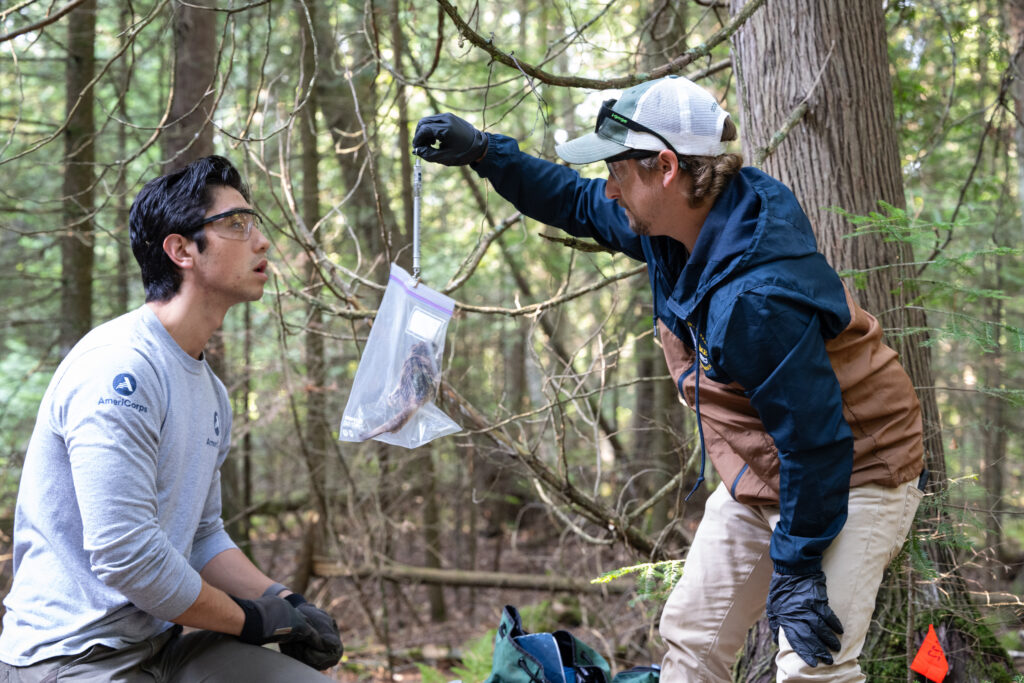In the News: The Ridges Documents Small Mammals
By Betsy Lecy , Peninsula Pulse – August 1st, 2024

(From left) Sam Hoffman weighs a flying squirrel, research director Tony Kiszonas writes down its measurements and WisCorp conservationist Albert Kennedy holds it in a plastic bag. Photo by Larry Mohr.
Surrounded by foliage and hundreds of feet off the hiking trail at the Ridges Sanctuary, WisCorps conservationist Albert Kennedy strategically held a flying squirrel as he removed it from a Camberg trap and transferred it into a plastic bag for measurement.
This is a daily routine for Kennedy, with 25 animal traps that are positioned and checked twice a week. The routine is part of Kennedy’s summer project through a partnership between WisCorps and the Ridges.
The research aims to establish a presence/absence survey that documents the small mammal species residing at the Ridges. Sam Hoffman, land manager at the Ridges, said this research is a part of the Ridges’ initiative to gather baseline surveys for an extensive species list. He said the Ridges has plant inventories and insect surveys, yet they have a void in research when it comes to small mammals.
“[Kennedy] is looking at a comprehensive way of getting a principal list of mammals, not just small mammals, but any and all mammal species that could be documented at the Ridges,” Hoffman said. “That was a need for the Ridges.”
Kennedy graduated from Hocking College with an associates degree, and will pursue a bachelor’s degree for wildlife research and management at West Virginia University. He also said he studied abroad in Canada last year, assisting in a similar small mammal project, as well as working with a biologist studying Southern flying squirrels in Ohio.

With this research though, Kennedy is spearheading the project.
For three weeks, Kennedy has sampled a mesic conifer forest and completed five rounds of trap-checking. He will be sampling a grassland meadow for the same time period to represent a diverse population in his research.
Before beginning his research, Kennedy reviewed several studies on best practices to ensure no mammals are harmed.
For instance, shrews have high metabolic rates and must constantly eat to maintain their energy levels, so Kennedy placed enough mealworms in the pitfall traps for them to survive. He also installed bedding at the bottom of the traps so the shrews have a comfortable place to fall, as well as drainage holes in case of rain.
Hoffman said Kennedy used a combination of five different traps in a 5-by-5 grid array: a large Tomahawk trap with a single opening, a smaller Tomahawk trap that opens from both sides, a Camberg live trap, a Sherman trap and a pitfall trap.
Each round of trap-checking also required Kennedy to measure the mammals’ features, including the weight and the lengths of the mammal’s hind, limbs, tail and ears.

Kennedy has documented eight species from trapping, including red squirrels, Southern flying squirrels, Northern flying squirrels, house mice, masked shrews, white-footed mice, American deer mice and a pygmy shrew. He was particularly surprised when he caught a Southern flying squirrel.
“I’ve heard of Southern flying squirrels being documented more south of Door County, but nothing has been documented this far north, especially at the Ridges,” he said.
The species’ range is expanding due to climate change, according to the Department of Natural Resources’ (DNR) initiative Snapshot Wisconsin. That’s because warmer climates make for more oak trees, which is largely where the Southern flying squirrels nest themselves.
But for Northern flying squirrels, which require more northern tree species to survive, their habitat is being diminished along with their population numbers.
“It’s going to push [the Northern flying squirrel population] out of their range even further up north, breeding less habitat,” Kennedy said. “So it’s something that we are watching for.”
Kennedy also caught a pygmy shrew in one of the five pitfall traps. He said this trap was “memorable” because it’s the first pygmy shrew to be documented in Door County.
The survey also involves data from Snapshot Wisconsin, a network of volunteer-managed trail cameras.
Kennedy reviewed the photos from the cameras during a three-month period to identify small mammal species. He documented 17.
“It was really cool to be able to add really important data, look at what I’ve done, replicate it and reference it,” he said.